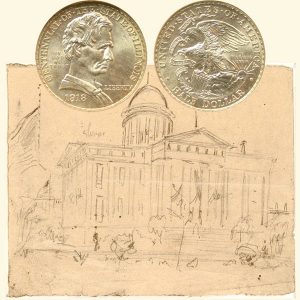Today, the Illinois Centennial Commemorative Silver Half Dollar Coin remembers when the Long Nine helped move the capital to Springfield and the state legislature’s first meeting there on December 9, 1839.
From the History of Springfield, Illinois, Its Attractions as a Home and Advantage for Business, Manufacturing, Etc. published under the auspices of the Springfield Board of Trade by John Carroll Power in 1871:
=====
From the time Sangamon county was organized and Springfield fixed as the county seat, it grew steadily though not rapidly.
Among the newcomers there was an unusually large number of men of more than ordinary talents, many of whom afterwards acquired National distinction.
Among these may be mentioned Abraham Lincoln, Stephen A. Douglas, E. D. Baker, and many others who are yet living.
When the question of relocating the Capitol came up, Sangamon county was very ably represented.
In the Legislature of 1836-7 she had two Senators and seven Representatives, who were not only men of talents, but persistent workers. They were the most remarkable delegation from any one county to the General Assembly, for the reason that they were much taller than the average of human stature.
I have just learned from one of the number — Hon. Ninian W. Edwards— who is yet living in this city, that some of them were a little less and some a little more than six feet, but that their combined height was exactly fifty-four feet.
For this reason they were then and are yet spoken of as the “Long Nine.”
The names of those in the Senate were, *A. G. Herndon and Job Fletcher; in the House, *Abraham Lincoln, Ninian W. Edwards, *John Dawson, *Andrew McCormick, *Daniel Stone, W. F. Elkin and Robert L. Wilson.
One or two were as tall, but none taller, than Abraham Lincoln, who was just six feet and two inches. Those marked with a star are all deceased.
The removal of the Capital was a foregone conclusion. The members of the Legislature found much fault with Vandalia, because they were fed almost entirely on prairie chickens and venison — very common articles of food at the time, although they are considered luxuries now; but the lawmakers wanted something better, or at any rate a change.
Perhaps no other place would have done better; but experience proves that when a body of Legislators wish to find fault with a town, it is easy to raise pretexts.
There was, however, a real necessity for moving the seat of government further north, as the tide of emigration set steadily in that direction, and the means of travel were confined almost entirely to stage coaches and riding on horseback.
The people of Illinois were, at that time, almost crazy on the subject of internal improvements. Not more than one in ten thousand of them had ever seen a railroad, but they had heard of them, and thought the prairies of Illinois the best place in the world to build them. Charters were granted for them in nearly all parts of the State.
The “Long Nine” were a unit for securing the State Capital, consequently did not jeopardize it by putting in claims for other improvements. The result was the passage of “An act permanently to locate the seat of government for the State of Illinois,” which was approved at Vandalia, February 25, 1837.
This law provided for a joint session of the two houses on the 28th of the same month, to select a situation. An appropriation of fifty thousand dollars was made, to commence building the State House.
The law also declared that no place should be chosen unless its citizens contributed at least $50,000 to aid in the work, and not less than two acres of land, as a site for the Capitol.
When the two houses assembled on the 28th, it was decided that Springfield should be the permanent seat of government of the State of Illinois.
A supplemental act was passed March 3d, authorizing the commissioners of Sangamon county to convey the land, as a site for the new edifice, to the State. It also named three commissioners, who were authorized and instructed to superintend the work.
It was expected that the new Capitol would be completed in time for the first meeting of the Legislature in Springfield, which was fixed for the special session of 1839-40.
Finding that this could not be done, the Second Presbyterian church, on Fourth street — the old building by the side of that in which the House of Representatives for 1871 transacted its business — was secured as Representative Hall, the Methodist church for the Senate Chamber, and the Episcopal church for the Supreme court.
The first was and is yet quite a commodious brick edifice; the two latter, small, wooden buildings, have long since disappeared as churches.
The Legislature first convened at Springfield, in special session, December 9, 1839.
=====
The Illinois Centennial Commemorative Silver Half Dollar Coin shows with an artist’s image of the State House, circa 1865.
